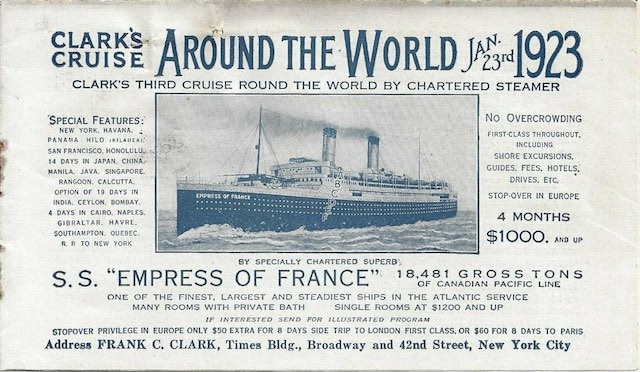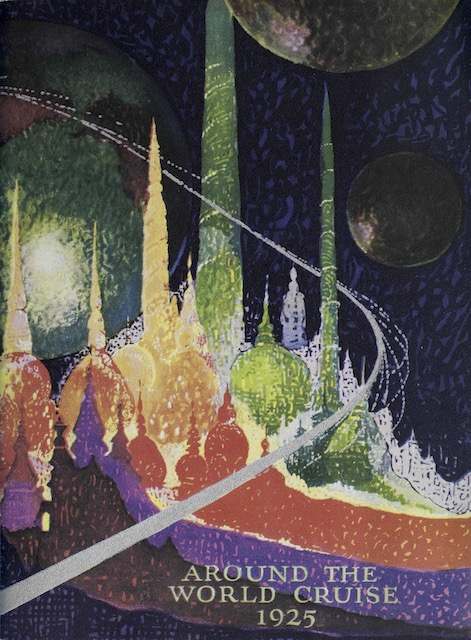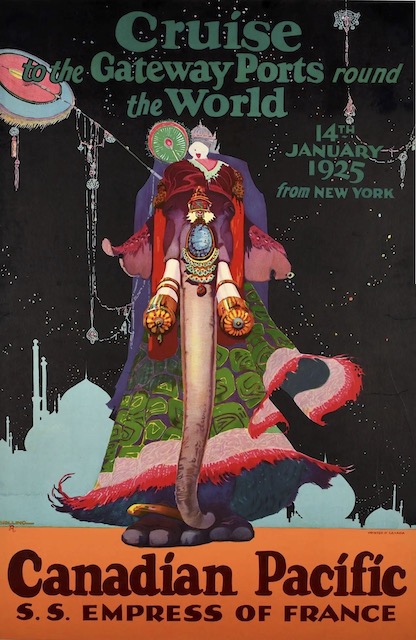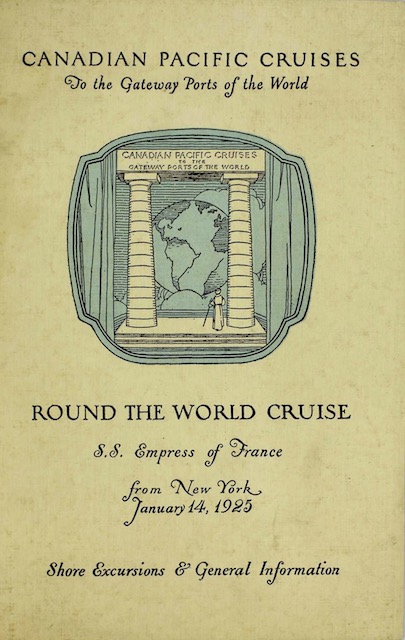Canadian Pacific elected to use the 11-year-old Empress of France for its 1925 world cruise. Launched in 1913 as the Alsatian by the Allan Line (which Canadian Pacific had controlled since 1909 but operated separately from its own ships until 1918), it left on its maiden voyage from Liverpool to St. John, N.B., on January 17, 1914.

The Empress of France as it appeared in 1925, before its hull was painted white, is shown on this cigarette card. Click image for a larger view.
After the war, CP integrated the Allan Line into its operations and renamed the Alsatian. The Empress of France continued to serve CP until 1931 and was scrapped in 1934 after making 99 Atlantic voyages, 5 Pacific ones, and 8 lengthy cruises, plus wartime service.

Cover of booklet advertising the Empress of France‘s 1923 world cruise. Click image for a larger view.
This wasn’t the France‘s first time around the world. In 1923, the Frank Clark travel agency in New York chartered the ship for a four-month around-the-world tour that left New York with 810 passengers on January 23. This tour, which went in a westerly direction instead of easterly as the later CP cruises did, is chronicled in a book by travel writer James T. Nichols. The France was one of four ships that had been chartered for around-the-world cruises that winter, the others being Cunard’s Laconia (chartered by American Express), its sister ship Samaria (charted by Thomas Cook), and the United American Line’s Resolute (chartered by Raymond-Whitcomb). The success of these charters may have inspired Canadian Pacific to begin its own round-the-world cruises in 1924.
 Click image to view and download a PDF of this booklet from the University of British Columbia Chung collection.
Click image to view and download a PDF of this booklet from the University of British Columbia Chung collection.
To publicize the 1925 trip, which was limited to 475 passengers, Canadian Pacific issued this lavish 44-page booklet with dozens of colorful illustrations signed “Holling.” This refers to Holling Holling, who was born Holling Clancy in 1900 but changed his name for “professional reasons.” A native of Michigan, he had worked on Great Lakes steamships, but graduated from the Art Institute of Chicago in 1923.

The signatures on this poster and in the above booklet match those in the children’s books that Holling wrote years later. Click image for a larger view.
This booklet isn’t mentioned in any of his on-line biographies, but it must have been one of his first professional commissions. In 1926, he got a taste of cruise ship travel when he and his wife went as art instructors on a round-the-world tour sponsored by New York University. He later gained fame as the author and illustrator of several popular children’s books, at least one of which was turned into an Oscar-nominated movie.
 Click image to view and download a PDF of this booklet from the University of British Columbia Chung collection.
Click image to view and download a PDF of this booklet from the University of British Columbia Chung collection.
This 76-page booklet provides much more information about the cruise, including an itinerary and a description of off-ship excursions that were included in the basic fare as well as additional options. The nearly 30,000-mile cruise left New York on January 14, returning May 23, for a total of 130 days. Of these, a cumulative 52 days were spent in 26 different ports and 78 days were at sea.
The basic fare was $2,000, which could grow considerably higher with more spacious accommodations and optional excursions. A table in the back of the booklet claims that the exchange rate between U.S. and Canadian dollars at the time was $1 to $1. In today’s U.S. dollars, the $2,000 base fare is nearly $35,000.
Excusions included in the base fare included trips to Pompeii, Jerusalem, Cairo (by train), the Great Pyramids, Peking, Kyoto, and many more cities that weren’t within walking distance of ports. Optional excursions ranged from a one-day tour in the area surrounding Naples for $5 (about $88 today) to a 15-day land tour of India for $350 (well over $6,000 today).
